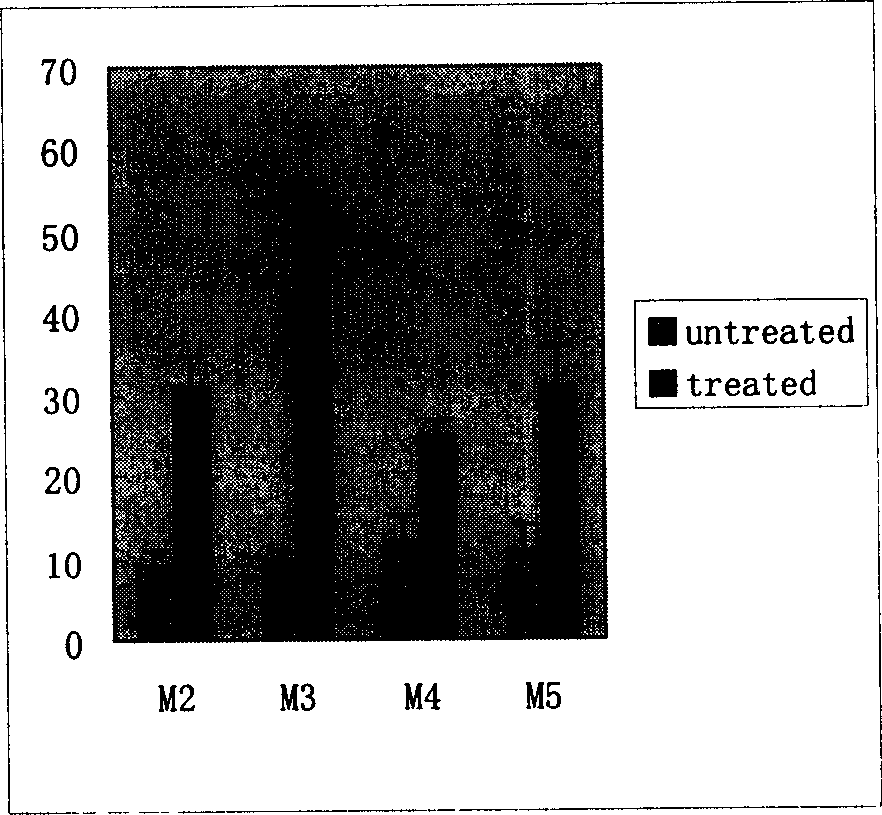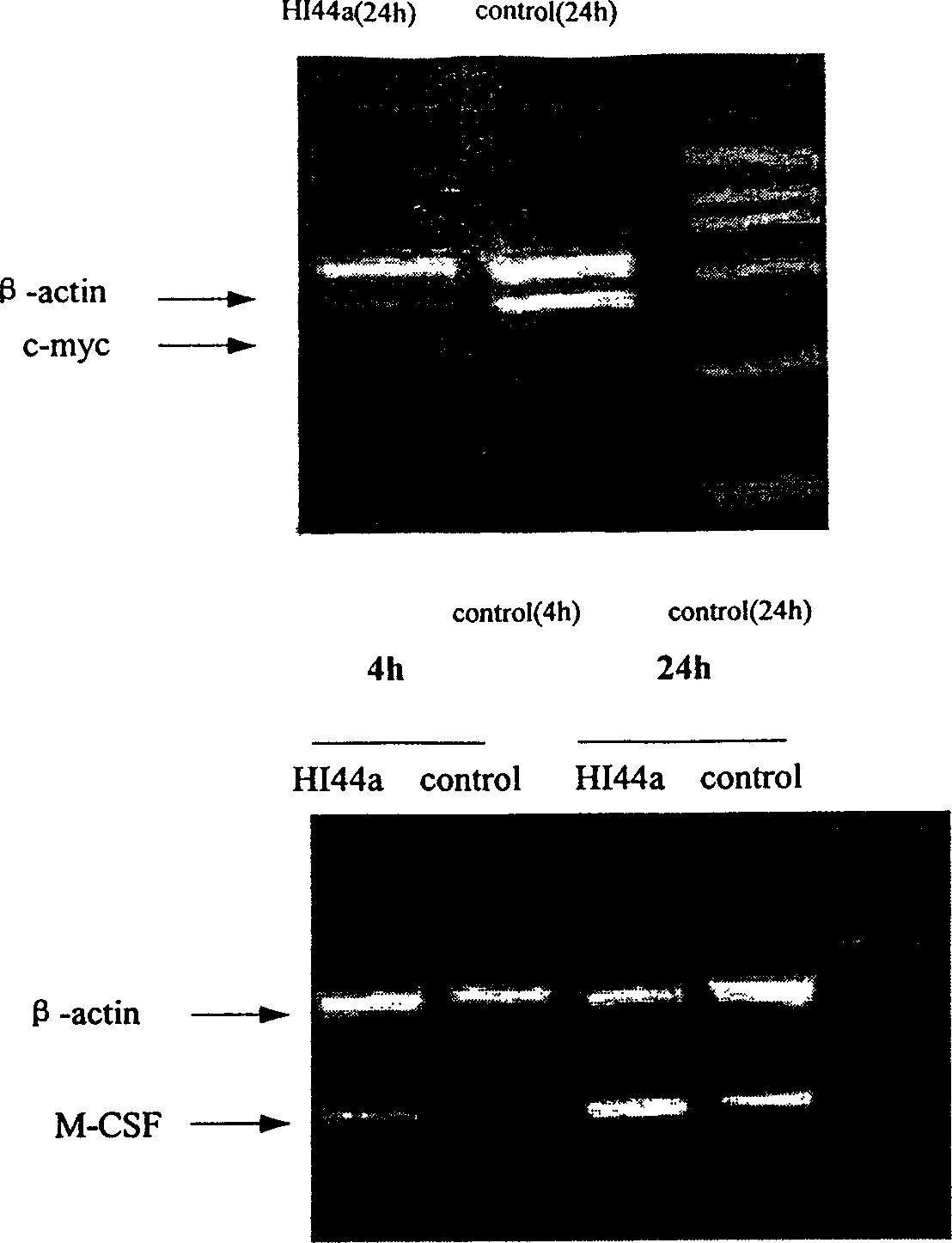Engineering antibody against CD44 for inducing leukemia cell differentation and necrosis
A leukemia cell and apoptosis technology, applied in the direction of antibodies, introduction of foreign genetic material using vectors, anti-tumor drugs, etc., can solve the problems affecting the effectiveness of clinical chemotherapy drugs, hematopoietic cell damage, toxic and side effects of the body, etc., and achieve easy mass production. , the effect of low antigenicity and low production cost
- Summary
- Abstract
- Description
- Claims
- Application Information
AI Technical Summary
Problems solved by technology
Method used
Image
Examples
Embodiment 1
[0033] Example 1: HI44a can effectively induce differentiation of leukemia cells
[0034] Take 5ml of bone marrow from a newly treated acute myeloid leukemia patient, separate and extract mononuclear cells, and use 2×10 5 / ml inoculated in a 24-well plate and co-cultured with the differentiation inducer HI44a. The culture condition is RPMI 1640 (containing 10% fetal calf serum), 37°C, 5% CO 2 , Saturated humidity for 4-6 days. After that, the cells were collected to detect changes in differentiation indicators.
[0035] (1) Changes in cell morphology. After leukemia cells are co-cultured with HI44a, they can obviously show the transformation of cell morphology to the direction of maturation. The cells show nuclear pyknosis, reduced nucleoplasm ratio, and reduced nucleolus. Among them, the leukemia cells of M3 and M5 subtypes are the most obvious, see figure 1 .
[0036] (2) Determination of NBT reduction ability. HI44a can significantly increase the NBT reduction ability of leuke...
Embodiment 2
[0062] Example 2 HI44a can effectively induce apoptosis of leukemia cells
[0063] The isolated leukemia cells were co-cultured with HI44a under RPMI 1640 (containing 10% fetal bovine serum), 37°C, 5% CO 2 , Saturated humidity for 48-72 hours, harvest the cells, wash with PBS, Annexin-V kit (Annexin-V-FLOUS staining Kit; ROCHE) to detect early cell apoptosis. After testing, 48-72 hours after HI44a acts on the leukemia cells of 10 patients, the early apoptosis rate of leukemia cells was significantly increased, as shown in Table 4.
[0064] Table 4 The effect of HI44a on early apoptosis of leukemia cells of various subtypes
[0065] Annexin-v positive rate (%)
[0066] FAB subtype Number of cases Control group HI44a group P
[0067] 1 8.18 13.13
[0068] AML2, n=2 2 2.45 40.11
[0069] 1 7.39 9.98
[0070] AML3, n=3 2 2.14 26.84
[0071] 3 59.54 75.77
[0072] 1 4.19 6.89
[0073] AML4, n=2 2 37.06 65.67
...
Embodiment 3
[0078] Example 3 HI44a can inhibit the expression of the proto-oncogene c-myc in leukemia cells, and enhance the expression of the specific differentiation inducing factor M-CSF
[0079] RT-PCR detects the expression changes of c-myc, G-CSF and M-CSF. Leukemia cells were co-cultured with HI44a for 24 hours, and then the cells were collected. Trizol (GIBCO) one-step extraction of total cell RNA, Oligod (T) as a primer, reverse transcription of M-MLV reverse transcriptase into cDNA. The housekeeping gene β-actin was used as an internal control. The primers for PCR amplification are: c-myc, 5'-CCC GAC GCG GGG AGG CTA TT-3' and 5'-TCT CCA GCT GGT CGG CCG TG-3'; G-CSF, 5'-TTG GAC ACACTG CAG CTG GAC GTC GCC GAC TT-3' and 5'-ATT GCA GAG CCA GGGCTG GGG AGC AGT CAT AGT-3'; M-CSF, 5'-CAG TCA GAT GGA GACCTC GT-3' and 5'-GGT GTC TCA TAG AAA GTT CG-3'. (The primers were synthesized by Shanghai Sangon Company). The PCR reaction conditions were: c-myc, denaturation at 94°C for 45s, annealing at ...
PUM
 Login to View More
Login to View More Abstract
Description
Claims
Application Information
 Login to View More
Login to View More - R&D
- Intellectual Property
- Life Sciences
- Materials
- Tech Scout
- Unparalleled Data Quality
- Higher Quality Content
- 60% Fewer Hallucinations
Browse by: Latest US Patents, China's latest patents, Technical Efficacy Thesaurus, Application Domain, Technology Topic, Popular Technical Reports.
© 2025 PatSnap. All rights reserved.Legal|Privacy policy|Modern Slavery Act Transparency Statement|Sitemap|About US| Contact US: help@patsnap.com



